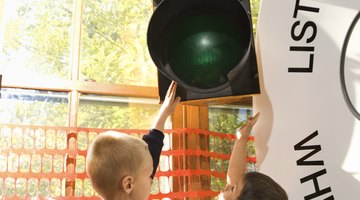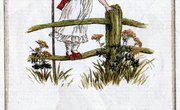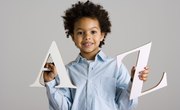“Look, Mommy. It’s a stop sign. It means we should stop, look and listen before we cross the street.” Familiar symbols dot the landscape, preschool classroom and your home. Your child recognizes these familiar signs before he can read. They become as familiar as his favorite cereal box or the logo for his favorite pizzeria. The symbols and labels may convey information he needs or that encourage him to beg you to stop and shop.
Traffic Signs
Your preschooler sees traffic signs every time she travels from your house to another destination. She quickly learns that the red light on the traffic light means “stop,” green means “go” and yellow means “be careful.” Stop signs, bus stop markers, flashing walk and stop lights at the crosswalk, “children at play” and yield signs also might be familiar to her. She understands that these signs help her stay safe if she obeys them. Her teacher might use replicas of these signs to remind the students to obey each sign, and she might also caution the children to always look first because not everyone obeys the signs.
International Icons
Language differences and lack of reading skills have inspired various signs that clearly mark places your child recognizes. For example, when he comes to doors with a man or woman outline, he knows he has found the restroom and he knows which door he should enter. He may not like entering the ladies’ room with you, because he knows he’s a boy and probably believes he’s getting too big to go in there with you. He might also recognize the open book sign for the library, the airplane that designates an airport, the phone symbol or the cross that identifies a church. You might print off some of the international signs and see just how many he can figure out without your help.
Familiar Icons
Your child probably can draw a smiling face or other emoticons that dot your email and text messages. She might quickly decide that the “yuck face” that identifies many household poisons means she shouldn’t touch or drink the substance, but she might find the skull and crossbones less familiar. If she doesn’t understand these icons, explain them. Icons can organize her room, such as pictures of toys, books or clothing items on containers so she can put items in the correct place.
Favorite Brands
A trip to the store or out on the road may demonstrate your child’s ability to recognize the icons of familiar soft drinks, fast-food restaurants, cereal or candy brands. Manufacturers create logos to identify their brand and your preschooler learns them quick. Even if the sound isn’t on during commercials, he can probably tell you what brand is being advertized. He might quickly notice if you choose an alternative brand rather than an item bearing a familiar logo.
Related Articles
References
Writer Bio
Rev. Kathryn Rateliff Barr has taught birth, parenting, vaccinations and alternative medicine classes since 1994. She is a pastoral family counselor and has parented birth, step, adopted and foster children. She holds bachelor's degrees in English and history from Centenary College of Louisiana. Studies include midwifery, naturopathy and other alternative therapies.











